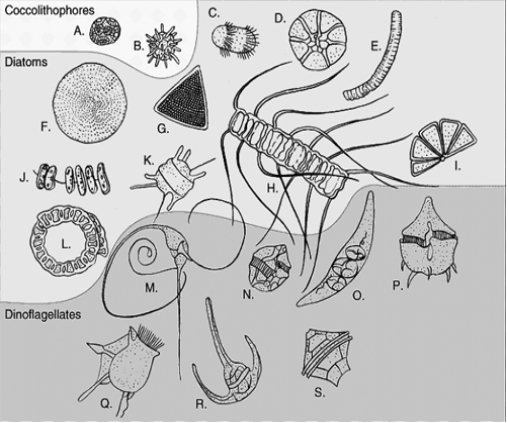Correct Answer

verified
Correct Answer
verified
Multiple Choice
When an organism has the same salt and water concentration as its environment,it is said to be:
A) euryhaline.
B) hypertonic.
C) hypotonic.
D) isotonic.
E) stenohaline.
Correct Answer

verified
Correct Answer
verified
True/False
A euryhaline organism would be poorly adapted to living in coastal environments.
Correct Answer

verified
Correct Answer
verified
Multiple Choice
The majority of marine invertebrates are:
A) adapted to life in the pelagic zone.
B) estuarine.
C) found only in benthic environments.
D) hypertonic with respect to their environment.
E) isotonic with respect to their environment.
Correct Answer

verified
Correct Answer
verified
Multiple Choice
Neritic marine environments would be found:
A) associated with continental shelves.
B) at mid-ocean ridges.
C) deep in the ocean basin.
D) in subduction zones.
E) within a deep-sea trench.
Correct Answer

verified
Correct Answer
verified
Multiple Choice
Organisms with small,expandable bodies,extremely large mouths,and efficient teeth are likely to be found in the:
A) bathypelagic zone.
B) epipelagic zone.
C) mesopelagic zone.
D) neritic province.
E) photic zone.
Correct Answer

verified
Correct Answer
verified
True/False
Osmosis occurs when salt ions diffuse through a membrane with a lower ion concentration.
Correct Answer

verified
Correct Answer
verified
Multiple Choice
Refer to the Figure below to answer Questions
 -The portion of the ocean in which these organisms are most likely to be found is the:
-The portion of the ocean in which these organisms are most likely to be found is the:
A) benthic zone.
B) estuary.
C) intertidal zone.
D) pelagic zone.
E) sediment layer.
Correct Answer

verified
Correct Answer
verified
Multiple Choice
Multicellular organisms that are comprised of eukaryotic,heterotrophic cells with cell walls would most likely belong to the kingdom:
A) Animalia.
B) Fungi.
C) Monera.
D) Plantae.
E) Protista.
Correct Answer

verified
Correct Answer
verified
Multiple Choice
Which of the following associations is incorrect?
A) Kingdom Animalia - dolphins
B) Kingdom Fungi - mushrooms
C) Kingdom Monera - bacteria in hydrothermal vents
D) Kingdom Plantae - macroalgae
E) Kingdom Protista - phytoplankton
Correct Answer

verified
Correct Answer
verified
True/False
The majority of marine species are pelagic.
Correct Answer

verified
Correct Answer
verified
Multiple Choice
The color pattern in which marine organisms are light on the bottom and dark on the top of their bodies camouflaging them against the water-air interface is:
A) countershading.
B) cryptic coloration.
C) defensive coloration.
D) disruptive coloration.
E) warning coloration.
Correct Answer

verified
Correct Answer
verified
Multiple Choice
When compared to their warmer water counterparts,cold water plankton often:
A) are larger in size.
B) are smaller in size.
C) exhibit countershading.
D) have more spines and ornamentation on the cell wall.
E) reproduce asexually only.
Correct Answer

verified
Correct Answer
verified
Multiple Choice
High latitude ocean water tends to support large planktonic communities because:
A) fewer predators that feed on plankton.
B) longer summer day length.
C) of higher dissolved gas concentrations.
D) there is abundant light.
E) there are abundant nutrients.
Correct Answer

verified
Correct Answer
verified
Multiple Choice
A small size is advantageous for marine organisms because it:
A) increases the ability to absorb nutrients.
B) increases the ability of wastes to diffuse out of the organism.
C) increases the surface area to volume ratio that in turn decreases density.
D) All of the above statements are advantageous to marine organisms.
E) None of the above statements are advantageous to marine organisms.
Correct Answer

verified
Correct Answer
verified
True/False
Epifauna live deep within benthic sediments.
Correct Answer

verified
Correct Answer
verified
Multiple Choice
Plankton which are 2.0 to 0.2 μm in size are called:
A) nanoplankton.
B) net plankton.
C) picoplankton.
D) phytoplankton.
E) zooplankton.
Correct Answer

verified
Correct Answer
verified
Multiple Choice
Refer to the Figure below to answer Questions
 -These planktonic organisms often have needle-like structures that:
-These planktonic organisms often have needle-like structures that:
A) are used as a defense mechanism.
B) are used as paddles to catch ocean currents.
C) increase density.
D) prevent sinking.
E) serve as a "skeleton" to support the diatom.
Correct Answer

verified
Correct Answer
verified
Multiple Choice
The sublittoral (subtidal) zone is the area:
A) above the highest tide.
B) below the intertidal zone on the continental shelf.
C) between the highest high tide and the lowest low tide.
D) beyond the continental shelf.
E) Where demersal and pelagic organisms are found.
Correct Answer

verified
Correct Answer
verified
Multiple Choice
Euryhaline organisms:
A) are less common than stenohaline organisms.
B) can survive wide salinity fluctuations.
C) require less oxygen for survival.
D) tolerate a narrow range of salinities.
E) tolerate small temperature changes.
Correct Answer

verified
Correct Answer
verified
Showing 21 - 40 of 54
Related Exams